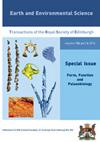Dynamic ecophenotypy in the Silurian Monograptidae (Graptolithina)
IF 1.2
4区 地球科学
Q4 GEOSCIENCES, MULTIDISCIPLINARY
Earth and Environmental Science Transactions of the Royal Society of Edinburgh
Pub Date : 2021-12-03
DOI:10.1017/S1755691021000402
引用次数: 0
Abstract
ABSTRACT The monograptids from the Wenlock and Ludlow (mid- to late Silurian) of the palaeotropical Baltic Basin exhibit thickened ring structures (sicular annuli) over their initial phase of growth. Appearing before the lundgreni extinction event, they persisted throughout the remainder of the Silurian, fluctuating in number over that period. To better understand the mechanisms controlling their development and variation, counts of sicular annuli were taken from three well cores in Lithuania, compared between species in each sample and compared with contemporaneous gamma ray data, accompanied by the stable isotope (δ13C), and acritarch diversity data. Mean counts of annuli fluctuated greatly over the studied interval, but showed negligible variation between species, indicating that the trait is ecophenotypic. The fluctuation in annulus presence aligned with variations in fourth- and fifth-order cycles derived from the gamma ray trends, which represent significant sea level fluctuations, δ13C ratios, and primary productivity, suggesting that annuli were more plentiful in high-stand states which are associated with the wetter climate and more productive conditions, whereas dryer, less productive conditions were not conducive to annulus development. In light of this evidence, we hypothesise that the action of upwelling as a result of intensified storm events during wetter periods would have encouraged phytoplankton blooms, increasing construction of annuli. These results show the potential utility of sicular annuli in the study of Silurian climate change and give new insights into graptolite palaeoecology.志留纪单钩藻科(Graptolithina)的动态生态表型
古热带波罗的海盆地的温洛克和勒德洛(志留纪中晚期)的各结体在其生长的初始阶段表现出加厚的环状结构(状环空)。它们出现在伦格里尼灭绝事件之前,在志留纪的剩余时间里一直存在,数量在那个时期有所波动。为了更好地了解控制其发育和变化的机制,研究人员从立陶宛的3口井岩心中采集了环状物的数量,比较了每个样品中的物种,并与同期伽马射线数据进行了比较,并结合了稳定同位素(δ13C)和骨干生物多样性数据。在研究区间内,环空的平均数量波动很大,但物种之间的变化可以忽略不计,表明该性状是生态表型的。环空存在的波动与伽马射线趋势得出的四阶和五阶旋回的变化一致,这代表了显著的海平面波动、δ13C比率和初级生产力,表明环空在高水位状态下更为丰富,这与气候湿润和生产力较高有关,而干燥、生产力较低的条件不利于环空的发育。根据这一证据,我们假设,在潮湿时期,由于风暴事件加剧,上升流的作用会促进浮游植物的繁殖,增加环空的建设。这些结果显示了状环空在志留纪气候变化研究中的潜在用途,并为笔石古生态学提供了新的见解。
本文章由计算机程序翻译,如有差异,请以英文原文为准。
求助全文
约1分钟内获得全文
求助全文
来源期刊
CiteScore
2.00
自引率
0.00%
发文量
21
期刊介绍:
Earth and Environmental Science Transactions (formerly Transactions of the Royal Society of Edinburgh: Earth Sciences) is a general earth sciences journal publishing a comprehensive selection of substantial peer-reviewed research papers, reviews and short communications of international standard across the broad spectrum of the Earth and its surface environments. The journal prides itself on the quality of its graphics and photographic reproduction. The Editors are keen to encourage interdisciplinary papers and Transactions also publishes occasional special symposia and invited volumes of specific interest.
We are currently in the process of digitising the archive of RSE Publications, and the archive of the Transactions, dating back to 1788, will be available from the back issues link on this site.

 求助内容:
求助内容: 应助结果提醒方式:
应助结果提醒方式:


